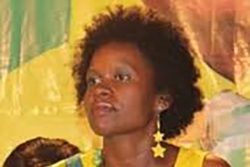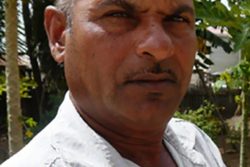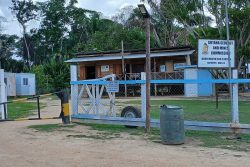Thirty-five years ago the first ever Caribbean Festival of Arts (CARIFESTA) was held in Guyana. When it returns next year, for the first time in over three decades Guyanese will experience seven days of rich cultural offerings from countries throughout the region.
From August 22 to 31 next year, there will be an attempt to recapture the atmosphere of ‘CARIFESTA 72’, out of which Festival City was born as the houses in that neighbourhood were built specifically for the visiting artistes. Those who were integrally involved in the hosting of the event recall the artistic creativity of Guyanese in making the event one to be remembered for years to come and perhaps the best-ever staging of CARIFESTA. It was held under the theme ‘The Artist in Society with Special Reference to the Third World’.
The event, which was held between August 25 and September 15 in 1972, was born out of two successive conferences of outstanding Caribbean writers and artists in 1966 and 1970, who recommended to then prime minister of Guyana, Forbes Burnham, that they would welcome the invitation to an annual festival of the arts. This would not have been difficult for Burnham to envision since he had already related his vision of a cultural mecca for the region’s people. According to reports, it was a vision of peoples with roots deep in Asia, Europe and Africa coming together to share, to perform their art forms. The dream embraced the literature inspired by the people’s peculiar Caribbean temperament, paintings inspired by their tropical jungles and art visualising their forefathers in the distant past.
For that first mega cultural showdown more than 1,000 creative artists were drawn from the peoples of more than 30 Caribbean and Latin American countries who all displayed the creative activity of music, dance, drama, folk art, painting, sculpture, photography and literature. Thousands of visitors were attracted by the art forms of the peoples of the wider Caribbean and they revelled in all the cultural offerings that year. The offerings included the folk chants and movements of the Conjunto Nacional of Cuba, the exotic Ibo dancers from Haiti and the sophisticated National Dance Company of Jamaica.
It was a sight to behold, according to those who witnessed the historic event. They recalled that masquerade and steel pan bands from participating countries led the masses in true Caribbean style through the streets Georgetown. Being the host country, Guyana spared no resources and energy to achieve a festival of unprecedented standard.
Cultural icon Daphne Rogers, former administrator of the National Cultural Centre (NCC), remembers that 1972 event clearly with pride because of how well Guyana did as a host country. According to her, art forms virtually poured out of the pores of the artistes and artists as they all came together to put on a cultural extravaganza worth more than money can buy.
Rogers said Burnham had thrown out the challenge to those who were on the planning committee to create something akin to a cultural revolution and they accepted the challenge and did not disappoint. “The quality of the participants and their performances were just striking,” she recalled.
Rogers, who had just returned from Canada and whose major task was to assist in costume making and allocating of houses to the participants in Festival City, recalled that the NCC was to be one of the venues for events including the grand opening ceremony. However, when CARIFESTA rolled around it was still just a structure without walls and a roof.
“So they got three large tents, two were used for the foyer and sitting arrangement and the third erected over the stage area. The sides were still open and they were enclosed with coconut branches, interwoven tightly together,” Rogers recalled. The first item on the opening afternoon was from the Jamaican dancers and “it was really a presentation most glorious and inspiring for the opening of the CARIFESTA,” she said. “I remember Guyana’s presentation very vividly, each country had an evening where they did something and ours was produced by Mr Frank Pilgrim, he was the cultural officer of Caricom. It was a musical drama, a very impressive mix of folk songs, cultural traditional stories, and dance interlaced, with dialogue and dramatic movements.
“The most entertaining aspect was how Miss Lou [Jamaican Louise Bennett poet/activist now deceasecarifesta1.jpgd] described her first visit to Guyana. It was really a laudable dramatic thing.”
Also remembering the glorious event is popular calypsonian, Malcolm Corrica well known as Lord Canary who wrote and performed the theme song aptly named “Welcome to CARIFESTA” and to this day can vividly remember all of the words. He recalled that it was a very “nice feeling” to perform in front of a big crowd but he mostly felt very proud that Guyana could have hosted such an event. “It was the first festival of its kind to be held in this part of the world, it was really the biggest ever cultural thing to happen in Guyana and the Caribbean,” he gushed.
There have been nine CARIFESTAs since 1972 and below is a table of where and when each was held. (samantha_alleyne2000@yahoo.com)
Carifesta 1 1972 Aug 25 – Sept 15 Guyana
Carifesta 2 1976 July 23 – Aug 2 Jamaica
Carifesta 3 1979 Cuba
Carifesta 4 1981 July 19 – Aug 3 Barbados
Carifesta 5 1992 Aug 22 – 28 Trinidad and Tobago
Carifesta 6 1995 Aug Trinidad and Tobago
Carifesta 7 2000 August 17 -26 St Kitts and Nevis
Carifesta 8 2003 August 25 – 30 Suriname
Carifesta 9 2006 Sept. – 22-Oct 1 Trinidad and Tobago








